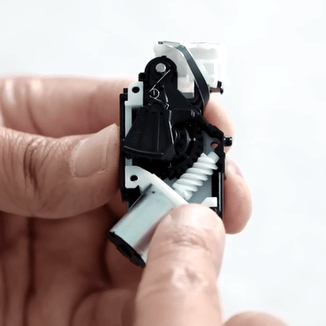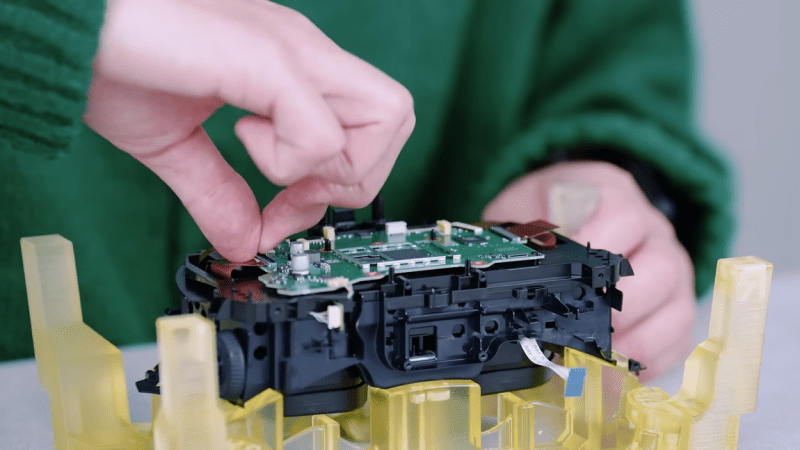Teardowns are great because they let us peek not only at a product’s components, but also gain insight into the design decisions and implementations of hardware. For teardowns, we’re used to waiting until enthusiasts and enterprising hackers create them, so it came as a bit of a surprise to see Sony themselves share detailed teardowns of the new PlayStation VR2 hardware. (If you prefer the direct video links, Engineer [Takamasa Araki] shows off the headset, and [Takeshi Igarashi] does the same for the controllers.)

One particularly intriguing detail is the custom tool [Araki] uses to hold the headset at various stages of the disassembly, which is visible in the picture above. It looks 3D-printed and carefully designed, and while we’re not sure what it’s made from, it does have a strong resemblance to certain high-temperature SLA resins. Those cure into hard, glassy, off-yellow translucent prints like what we see here.
As for the controller, we get a good look at a deeply interesting assembly Sony calls their “adaptive trigger”. What’s so clever about it? Not only can it cause the user to feel a variable amount of resistance when pulling the trigger, it can even actively push back against one’s finger, and the way it works is simple and effective. It is pretty much the same as what is in the PS5 controller, so to find out all about how it works, check out our PS5 controller teardown coverage.
The headset and controller teardown videos are embedded just below. Did anything in them catch your interest? Know of any other companies doing their own teardowns? Let us know in the comments!















With the ‘recent’ trend of glue and melting parts together i always love to see this (a company making a video about taking apart their product) but at the same time it always makes me wonder if they are really showing everything they could.
At any rate i totally agree that more companies should do this, especially now that the right to repair has become a law in one of the biggest markets. The only recent cases of companies doing this that come to mind are Valve and some phone company im not sure about (OnePlus? FairPhone? one of those guys) but imho all companies should just at the very least have guides on how you open a thing without breaking the tabs or tiny ribbon cables or whatever.
Most companies currently couldn’t do this – their products are not designed in such a way that repair is accessible even with relatively specialist tools.
So yeah I’d love it if they did – as that suddenly means design for repair.
One thing that came to mind was that it took much longer than the videos to shoot. There are at least 4 different cameras/angles of view, but you never see them. Everything is sped up (the boring parts like unscrewing). It obviously has a point for the manufacturer and consumers (it’s as much a guide as an ad in practice), but maybe they don’t see the point : why bother if other people end up doing it in your place (Ifixit for example) ?
Wait a minute, an ‘engineer’ handling electronics with wool clothing on and no ESD strap?….
It’s $ony, they can afford it.
And if clueless newbs destroy their gear, $ony doesn’t care.
I’m an embedded engineer, and I generally don’t pay any attention to ESD. If I manage to destroy something I’m working on just touching it, it’s an opportunity to make the circuit more robust. Better than having it fail while in a moving car or aircraft. At some point the electrical engineers should be zapping it all with an ESD gun anyway!
As an electrical engineer my experience is that you can usually do what ever you want and the chip will not die. Thats because of the ESD safety diodes at every chip pad.
However, my other experience is that, if there are no ESD diodes, just an ESD strap is not good enought and you will definitely fry the chip just by touching it. In that case you need a complet ESD save environment.
At least that is me experience working with single 1.8V MOSFETS without ANY protective diodes.
I’m sure there are those who use ankle ESD straps too.
Allows more flexible movement.
I only use the wireless ESD straps. I don’t like being tethered to the desk. :)
Most peoples japanese is so simple. I guess everyone knows now, what *hazusu* means? I can’t even begin to count xD
(of course the language doesn’t matter too much for great disassemblies)
Yeah, it’s a lake n the Colorado River.
Ah yes, another Vomit Reality headset. It may be uncomfortable and incredibly disorienting to use, but look at how easily you can disassemble it before you chuck it in the bin!
Seriously guys, stop inventing hardware that takes the fun and relaxation out of gaming. That’s not the point of video games. Either fix the motion sickness or don’t bother announcing new hardware.
My car requires my full attention otherwise I might crash and die. Either fix the lack of self driving or don’t bother announcing new cars.
Ok that was a terrible analogy, but I just want to point out that there are space for not-perfect products, especially if they are on the leading edge of current technology.
When you sell the hardware at a loss you have no worry you’ll be copied
Speak for yourself, yo. I have a great time in VR.
VR can be great, really immersive with the freedom to look where you want freely and move and interact way faster and more deliberately than the contextual button prompt KB/controller. If you don’t want that type of gameplay experience that is fine, some folks apparently like games that to me seem to lack anything resembling gameplay at all – doesn’t mean such stuff shouldn’t exist for those that do want it!
Plus to ‘fix’ the motion sickness is something that isn’t on the electronics anyway – motion sickness will happen to those susceptible to it. There are methods to constructing a game that probably make it less immersive, or put severe limitations on gameplay options but should mitigate the conflict between the inner ear and eyes – friend of mine who does get motion sickness has been able to enjoy VR in at least some titles, and nothing I’ve tried in VR has bothered me (at least when the fps is stable enough – minorly disconcerting when the view freezes mid motion)
While I’ve read some interesting hypothetical methods you could use to try and force or trick the inner ear report to match what your eyes are showing I highly doubt those methods can ever be enough for everyone. In the same way motion sickness patches are not.
You expect people to stop doing things just because you can’t do them or don’t like them? Get a grip. Don’t buy the product.
A really long winded way of saying: “if I don’t enjoy something, no one should be able to!”
This one does 120Hz, so that will be enough for some people to fix such issues.
And for those that simply can’t deal with 3D headsets: avoid them but don’t pretend that it’s not an personal issue, for you and a percentage of people in the same boat.
I myself get nausea from some regular games, but only a percentage of them, no idea why for those I have it and other games I don’t. And there is also a time difference, there are games where I get it in a minute and games where I can play ten minutes before it hts me. And as I indicated, games where I can play hours without issue.
A great first step, but I would love to see them post pictures and instructions on iFixit.
My issue is that Sony has a notorious history of doing nasty/illegal stuff to the consumer, and so I’m a bit concerned that eye-tracking camera collects a retinal image of the user. Silly, yes, but if you know Sony.. perhaps not so silly.
Incidentally, that vibration motor in the headset seem to be a really classical big and slow-reacting deal, which surprises me a bit, I would have expected something more haptic-engine-like or at least several smaller ones so it can respond faster